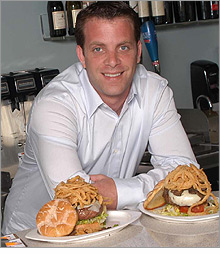http://pearlparadise.com/Jeremy Shepherd didn't expect to discover a multimillion-dollar business while working the skies as a flight attendant for Northwest Airlines.
But on a layover in Beijing, he bought a set of freshwater pearl jewelry at a local market -- earrings, a bracelet, and a necklace -- for $20. He gave the pearls to his girlfriend in the U.S. for Christmas, and she had them appraised: the value, $600, or 30 times what he had paid.
Mr. Shepherd was in business.
Now, about nine years later, he presides over PearlParadise.com, an online purveyor of the lustrous objects -- offering a wide line of jewelry from the popular akoya pearls to the more exotic Tahitian and South Sea varieties. The Santa Monica, Calif., company logged $5 million in sales last year, supplying the jewelry to 13 other Web sites that sell pearls around the globe.
Building a luxury business online isn't easy, especially when you're asking people to spend big dollars for something they can't even touch. It can be especially tough for a small company, which doesn't have a brand name that people will instinctively trust. But by courting both customers and suppliers, Mr. Shepherd found a formula that has worked.
"Building that trust can be difficult and all new sites have to break that barrier when they start," the 31-year-old Mr. Shepherd says. "That's the most difficult thing to overcome because so much of it is based on reputation and your name. Referrals and repeat business are a huge percentage of our customers."
So how did he do it? For one thing, blanketing the Web site with educational materials on how pearls are produced and on the different varietals helped put customers at ease, he says, as did prominently displaying the company's membership with organizations like the Better Business Bureau and the Safe Shopping Network.
Providing customers with assurances about selections helps, too. All pieces are accompanied by a 90-day money-back guarantee, and an appraisal, while high-resolution pictures serve as a substitute for being able to actually touch the real thing. Nearly all pieces also come with a second-appraisal guarantee: If a customer has the jewelry appraised on their own, the company assures them that it will be valued for at least five times the price the customer paid PealParadise.
And, when customers do call or email, their questions are handled by knowledgeable staff, all of whom received pearl certificates from the Gemological Institute of America, a trade and industry group based in Carlsbad, Calif.
But the biggest boost to credibility comes from the satisfied customers. "Word of mouth is a very strong tool," Mr. Shepherd says. "Having a happy customer has been the core of this business. They do tell people. It gets to a point where you reach a critical mass and you really start to expand, and that's why so much of our business has been referral and repeat business."
To keep his customers talking, Mr. Shepherd plans events that appeal to them directly. Twice a year -- before Mother's Day and Christmas -- he invites clients to a special Web page built just for them, featuring items practically at his cost. Last Christmas's event -- one of the items included strands of exotic Tahitian pearls -- yielded $100,000 in sales.
"People tend to buy more than those special pieces," Mr. Shepherd says. "The sales on those days are just astronomical."
In his latest marketing pitch, he hopes to strengthen his business's credibility further by sending past and new customers a documentary on pearling, which he narrates and which was shot at one of his suppliers' pearl farms in China.
Pounds of Pearls
Mr. Shepherd travels to Asia each month -- making stops in Japan, Hong Kong, and the Guangdong Province in China -- carrying back two sacks of pearls that together weigh more than he does. After extensive research -- and facing increased competition online -- he decided to find and deal with the pearl farmers directly, cutting out the middleman and enabling him to sell the pearls at a lower price than his competitors.
His proclivity for languages also helped: Already fluent in Japanese, he zipped through Berlitz's Mandarin course, spending the last few months on the art of negotiation using pearls as a discussion point; now, he talks with his suppliers in their native language, enabling him to forge closer relationships.
Oscar Baskets
Mr. Shepherd's depth of knowledge also has won him fans in Hollywood, yet another facet of his marketing strategy. After donating sets of black freshwater pearls for about 110 gift baskets for the 2004 Oscar nominees, this year he provided gift certificates instead. That required celebrity recipients to make an appointment to pick up their strands of baroque Tahitians at a showroom the company maintains at its Santa Monica headquarters.
"A lot of them have come back, and a lot have sent their friends," he says. "People buy from our Web site specifically because we gave [pearls] away at the Oscars." Inclusion in the bag also won PearlParadise snippets on television news shows, and next year Mr. Shepherd wants to have celebrities actually wearing their baubles down the red carpet.
PearlParadise's most visible marketers, however, have been its Web site resellers, which now account for about half of its annual sales. In 1997, PealParadise's online sales and sales to Internet resellers were about $8,000; they jumped to $250,000 in 2002, more than $3 million in 2003, and $5 million last year.
PearlParadise has three other major Internet resellers in the U.S., with the remainder in Europe and Canada. Each of the sites -- which operate much like franchises but with different names -- have somewhat different offerings, from special diamond clasps to cuff links, which Mr. Shepherd supplies to them exclusively.
"I try to give them as much control as possible because they all have their own marketing ideas and want to differentiate themselves," he says. "They all find their own little niche and exploit it."
PearlParadise is venturing into higher-end waters, as well, with pearls from French Polynesia and the South Sea. Mr. Shepherd has been selling several gem-quality Tahitian necklaces each week, ranging from $2,600 to $4,000. The largest sale booked so far was a $43,250 golden South Sea pearl necklace.
But the traditional, more affordable akoya strands remain his top sellers. "When we started, our motto was 'making the beauty of pearls available to everyone,' " he says. "And that is where our core customer still is -- the man who wants to buy a necklace for his wife, but knows it's $2,500 in a store but $350 on PearlParadise."
Pearls: A Natural HistoryBritney collapses in New Year stupor















